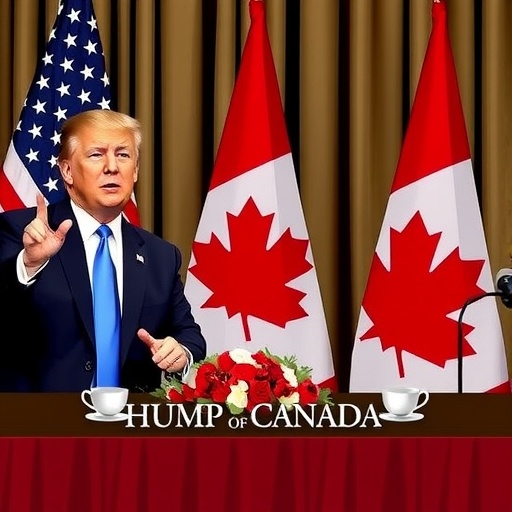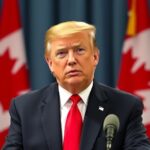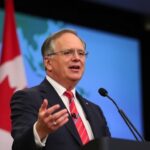Trump Escalates Trade War with Canada: New Tariff Threats Over Controversial TV Ad Ignite ASEAN Summit Backlash
In a bold and unexpected move that has sent shockwaves through international markets, President Donald Trump has threatened to impose new tariffs on Canada, citing a controversial television advertisement as the catalyst for renewed trade hostilities. The announcement, delivered via a fiery social media post late Wednesday, comes just as Canadian Prime Minister Mark Carney used the stage of the ASEAN Summit to advocate for stricter adherence to global trade rules, highlighting a stark divide in North American trade policy. This escalation risks unraveling fragile post-pandemic economic ties, with analysts warning of potential price hikes for consumers on both sides of the border.
- Trump’s Tariff Ultimatum: A Direct Rebuttal to Canadian Media Campaign
- Carney’s ASEAN Summit Address: Championing Multilateral Trade Amid U.S. Isolationism
- Economic Ripples: How New Tariffs Could Reshape North American Supply Chains
- Global Backlash and Diplomatic Maneuvers: Allies Weigh In on Trade Policy Clash
- Looking Ahead: Pathways to De-Escalation or Deeper Trade Policy Divide
Trump‘s rhetoric, which labeled the Canadian TV ad as “fake news propaganda,” accuses it of misrepresenting U.S. trade practices and undermining American workers. The ad, aired by a Canadian advocacy group, depicted U.S. tariffs as predatory tools that harm bilateral relations—a narrative that Trump dismissed as an affront to fair trade. With the U.S. economy still recovering from inflationary pressures, this threat adds another layer of uncertainty to an already volatile global landscape.
Trump’s Tariff Ultimatum: A Direct Rebuttal to Canadian Media Campaign
President Trump’s threat of new tariffs on Canada marks a significant escalation in what has been a simmering undercurrent of trade tensions since the renegotiation of the USMCA agreement. The specific trigger? A 30-second TV spot that began airing across major Canadian networks last week, produced by the non-partisan group Canadians for Fair Trade. The ad featured testimonials from lumber workers in British Columbia and auto manufacturers in Ontario, claiming that existing U.S. tariffs on steel and aluminum have cost Canadian jobs and inflated prices for everyday goods like cars and appliances.
“This ad is nothing but a witch hunt against American success,” Trump posted on Truth Social, vowing to slap a 25% tariff on Canadian imports if the ad isn’t pulled immediately. He further elaborated during a White House briefing, stating, “Canada thinks they can play games with our trade policy? We’ll show them what real leverage looks like.” This isn’t mere bluster; historical precedents from Trump’s first term, including the 2018 steel tariffs that affected $16 billion in Canadian exports, suggest he means business.
Economists at the Peterson Institute for International Economics estimate that new tariffs could add up to $2,500 annually to the cost of living for the average American household, primarily through higher prices on imported Canadian oil, lumber, and agricultural products. Canada, which sends about 75% of its exports to the U.S., faces even steeper risks—potentially losing 200,000 jobs in export-dependent sectors, according to a recent report from the Canadian Chamber of Commerce.
The TV ad itself, while provocative, was intended to rally public support ahead of bilateral talks. Featuring stark visuals of shuttered factories and families struggling with bills, it ends with a call to “respect the rules of trade.” But Trump’s response has overshadowed its message, turning a domestic Canadian debate into an international flashpoint.
Carney’s ASEAN Summit Address: Championing Multilateral Trade Amid U.S. Isolationism
At the ASEAN Summit in Jakarta, Indonesian capital buzzing with diplomats from Southeast Asia and beyond, Canadian Prime Minister Mark Carney delivered a impassioned defense of multilateral trade frameworks. Speaking on the summit’s second day, Carney urged member nations to “uphold the spirit of WTO rules in an era of unilateral actions,” a veiled critique of Trump’s tariff threats. “Trade policy should build bridges, not walls,” he declared to thunderous applause from ASEAN leaders, who are navigating their own disputes with major powers like China and the U.S.
The ASEAN Summit, attended by representatives from all 10 member states plus dialogue partners, focused on supply chain resilience and digital trade. Carney’s intervention came during a panel on regional economic integration, where he highlighted Canada’s role as a stable trading partner. “We’ve seen tariffs disrupt lives and economies before. Respecting agreements like the USMCA isn’t optional—it’s essential,” Carney said, directly referencing the North American pact that Trump himself touted as a victory during his presidency.
Carney, a former governor of the Bank of Canada and Bank of England, brought his financial acumen to the fore, citing data from the International Monetary Fund (IMF) that shows protectionist measures could shave 0.5% off global GDP growth in 2024. His speech resonated particularly with ASEAN nations, many of which rely on open trade routes for electronics and commodities. Vietnam’s Prime Minister, for instance, echoed Carney’s sentiments, warning that “escalating tariffs between allies like the U.S. and Canada could cascade into broader instability.”
Behind the scenes, sources close to the summit reveal that Carney held private meetings with U.S. Trade Representative Katherine Tai, pushing for de-escalation. Yet, Trump’s public threats, timed just hours after Carney’s address, have complicated these efforts, painting Canada as a unified front against perceived American aggression.
Economic Ripples: How New Tariffs Could Reshape North American Supply Chains
The potential imposition of new tariffs on Canada isn’t just diplomatic saber-rattling—it’s a direct threat to the integrated economies of North America. Under the USMCA, which replaced NAFTA in 2020, the U.S. and Canada enjoy tariff-free trade on most goods, fostering a $1.2 trillion annual exchange. Industries like automotive manufacturing, where parts crisscross the border multiple times before final assembly, are particularly vulnerable. A 25% tariff could increase vehicle production costs by 10-15%, according to the Alliance for Automotive Innovation, potentially leading to layoffs at plants in Michigan and Ontario alike.
Agriculture stands to suffer as well. Canada is the U.S.’s top supplier of softwood lumber, providing 25% of American construction needs. Tariffs here could drive up housing costs, exacerbating the U.S. affordability crisis. On the energy front, with Canada exporting 4 million barrels of oil daily to the U.S., any duties would spike gasoline prices at the pump—analysts from S&P Global predict a 20-30 cent per gallon increase in Midwest states.
Statistics underscore the stakes: Bilateral trade supports 2 million U.S. jobs and 1.7 million in Canada, per U.S. Commerce Department figures. A trade war revival could mirror the 2018-2019 spat, which cost U.S. farmers $27 billion in lost exports before bailouts. Small businesses, often the backbone of cross-border commerce, are already voicing concerns. “We’re not political players; we’re just trying to sell our maple syrup and craft beer without extra taxes,” said Tom Reynolds, owner of a Vermont-based importer, in an interview with Reuters.
Moreover, the tariffs could accelerate supply chain diversification. Companies like Ford and General Motors have already invested in Mexican facilities to hedge against U.S.-Canada frictions, a trend that might intensify if tensions boil over. For consumers, the hit is immediate: Higher tariffs mean pricier groceries, from Canadian wheat in U.S. bread to American tech in Canadian smartphones.
Global Backlash and Diplomatic Maneuvers: Allies Weigh In on Trade Policy Clash
The international community has reacted swiftly to Trump’s tariff threats, with allies and adversaries alike decrying the move as a setback for global trade stability. At the ASEAN Summit, Australian Prime Minister Anthony Albanese called the U.S. stance “short-sighted,” noting that similar protectionism has stalled progress on the Indo-Pacific Economic Framework. Even within NATO, where Canada and the U.S. are key partners, the rhetoric has raised eyebrows—French President Emmanuel Macron tweeted, “Trade wars weaken alliances; dialogue strengthens them.”
China, ever opportunistic, has positioned itself as a voice of reason, with state media praising Carney’s multilateral approach while subtly criticizing U.S. “bullying.” Beijing’s commerce ministry issued a statement warning that North American tariffs could disrupt global commodity flows, indirectly benefiting China’s Belt and Road initiatives in Southeast Asia.
Domestically, U.S. business lobbies are mobilizing. The U.S. Chamber of Commerce penned an open letter to Trump, arguing that “new tariffs on Canada would harm American competitiveness without addressing the ad’s underlying grievances.” Canadian officials, meanwhile, are preparing retaliatory measures, with Ontario Premier Doug Ford hinting at duties on U.S. whiskey and cheese—echoing 2018 tit-for-tat actions.
Diplomatic channels remain active. The White House has scheduled virtual talks with Carney for next week, but Trump’s unfiltered style suggests compromise may be elusive. Experts like trade lawyer Simon Lester from the Cato Institute predict a “cooling-off period” but warn that without resolution, this could spill into WTO disputes, further straining international trade policy norms.
Looking Ahead: Pathways to De-Escalation or Deeper Trade Policy Divide
As the dust settles from Trump’s tariff threats and Carney’s ASEAN Summit clarion call, the path forward for U.S.-Canada relations hangs in the balance. Short-term, markets are jittery: The Canadian dollar dipped 1.2% against the U.S. dollar following the announcement, while U.S. stock futures in tariff-sensitive sectors like manufacturing fell 0.8%. Long-term, this episode could redefine trade policy in the region, prompting calls for USMCA reforms to include media dispute mechanisms—a novel idea floated by think tanks like the Brookings Institution.
If de-escalation prevails, bilateral working groups could address the TV ad’s concerns through joint fact-finding, preserving the economic symbiosis that has defined North American prosperity. However, persistent escalation might embolden other nations to adopt protectionist stances, fragmenting global supply chains and inflating costs worldwide. IMF projections already factor in a 0.3% hit to Canadian GDP if tariffs materialize, with ripple effects for U.S. growth at 0.2%.
Stakeholders on both sides emphasize dialogue. “Trade policy thrives on trust, not threats,” Carney reiterated in a post-summit presser. Trump, for his part, has hinted at flexibility, telling reporters, “If they pull that ad and play fair, we can talk.” As negotiators gear up, the world watches whether this flare-up will fizzle into cooperation or fan the flames of a broader trade war, with implications for everything from EV battery production to cross-border tourism recovery.
In the coming weeks, expect heightened scrutiny at forums like the G7 and WTO, where leaders will push for rules-based trade. For now, the controversial TV ad—still airing despite the uproar—serves as a reminder that in the arena of international relations, words and images can be as potent as policy itself.









